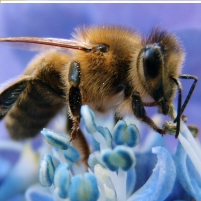What Killed the Honeybees, Fungus or Pesticides?
Tuesday, October 12, 2010

Scientists and beekeepers have been searching for an explanation to the massive die-off of honeybees during the last four years as the result of a syndrome known as colony collapse disorder. Honeybees pollinate about 30% of all food consumed and contribute $15 billion a year in agriculture revenue for the U.S. Some experts have pointed the finger at other species, others at viruses and fungi, and still others at a special kind of pesticide (neonicotinoids) that kills insects by attacking their nervous systems.
The New York Times recently gave weight to a study that blamed a combination of fungus and virus for the honeybee deaths. But as journalist Katharine Eban points out, the Times didn’t bother to mention that the study’s lead author, Montana bee researcher Dr. Jerry Bromenshenk, had received funding from Bayer CropScience, a manufacturer of neonicotinoids. In fact, Bromenshenk once worked with North Dakota beekeepers on their lawsuit against Bayer, but dropped out and was given a grant from the company.
One theory is that neonicotinoids weaken the bees, making them more susceptible to fungi and viruses, much as HIV weakens the immunity systems of humans, leading them to die of other causes.
-Noel Brinkerhoff
What a Scientist Didn't Tell the New York Times about His Study on Bee Deaths (by Katherine Eban, Fortune)
Scientists and Soldiers Solve a Bee Mystery (by Kirk Johnson, New York Times)
- Top Stories
- Unusual News
- Where is the Money Going?
- Controversies
- U.S. and the World
- Appointments and Resignations
- Latest News
- Trump to Stop Deportations If…
- Trump Denounces World Series
- What If China Invaded the United States?
- Donald Trump Has a Mental Health Problem and It Has a Name
- Trump Goes on Renaming Frenzy






Comments